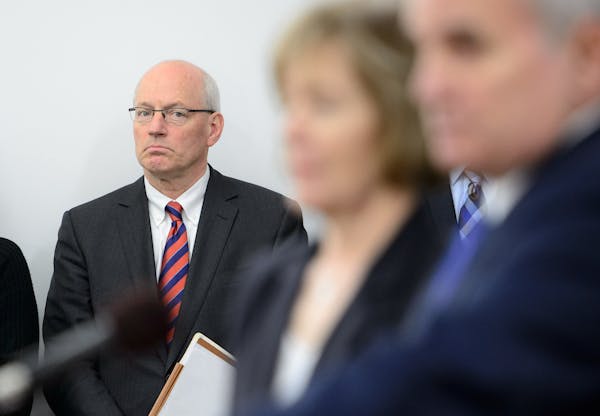Gravy is back on the gravy train for the top executives at Minnesota's publicly traded companies.
The median level of compensation for the 95 chief executive officers who run those companies rose 18 percent last year to $1.21 million, up from $1.026 million in 2013, and the second highest since the eve of the Great Recession in 2007.
The increases come at a time when reports show that average workers' pay is stagnant. According to the Minnesota Department of Employment and Economic Development, average hourly wages in the state have actually fallen since 2006. The average worker's inflation-adjusted pay has dropped from $27.46 per hour to $25.75 per hour.
But the level of CEO pay also suggests that companies are healthier since much of a CEO's compensation is based on stock price.
Last year's pay packages — including salary, bonus, options exercised and shares vested — ranged from $97.4 million for Ameriprise Financial CEO James Cracchiolo to $99,602 for Curtis Sampson of Communications System Inc.
Of the 95 CEOs in Minnesota, 14 made more than $10 million while 52 collected at least $1 million.
A Star Tribune analysis of compensation awards found that the salary and bonus portion of CEO pay increased 15.2 percent while long-term stock incentives jumped 67.5 percent as company boards followed an emerging national trend to tie pay to performance.
"That tends to be where the big money is," said Hillary Sale, a professor of management and law at the Washington University School of Law in St. Louis. "It keeps people on the job and focused on the long run."
Indeed, long-term equity incentives showed some stupendous increases for Minnesota CEOs last year. The options and restricted stock package for Ecolab's Douglas Baker Jr. jumped nearly 900 percent to $43.4 million. Douglas Milroy of G&K Services saw his stock package climb 808 percent, from $743,500 to $6.7 million. At Clearfield Inc., the fiber optics management firm, the stock portion of CEO Cheryl Beranek's compensation rose 637 percent to $3.7 million.
According to executive compensation experts, the move to long-term equity awards reflects greater attention by boards of directors on all aspects of executive pay, an effort at greater transparency for stakeholders and a move to tie compensation to the creation of long-term value, which buoys the returns to both the CEO and the shareholder.
But the take on tying compensation to performance is not universally embraced.
"A firm's stock price goes up when the whole market goes up, and that has little to do with the performance of an executive," said Lawrence Mishel, president of the Washington, D.C.- based Economic Policy Institute.
Mishel blames the growth in performance-based pay on a more than 20-year-old policy that allows companies to use performance-based pay, such as stock options, as a tax deduction.
And that, said Mishel, contributes to a growing pay gap between CEOs who run a company and workers who perform the tasks that govern productivity.
"This moves money to a certain group and away from the rest of us. God didn't create the world this way. It was set up by human beings, and it can be changed," Mishel said.
The Economic Policy Institute's annual corporate compensation study, released last month, determined that CEOs in the 350 largest U.S. firms received more than 300 times the income of typical non-managerial employees.
That ratio was up from 20-1 in 1965, 30-1 in 1978 and 59-1 in 1989.
"We need a change in the norms," Mishel said. "It used to be embarrassing to have this kind of disparity."
But if pay packages are getting bigger, they are also getting easier to find and understand.
The recent advent of "say on pay" resolutions, especially in Minnesota, suggests companies are making strides in the areas of transparency and communication.
According to a survey conducted by Institutional Shareholder Services (ISS) for the Star Tribune, support for say-on-pay proposals for Minnesota companies has jumped from 90.6 percent in 2013 and 2014 to 94.1 percent this year.
"That is a significant jump in the level of [shareholder] satisfaction," said Peter Kimball, vice president of ISS Corporate Solutions, a division of ISS that advises companies on executive compensation practices. "Part of that has to do with companies understanding better what shareholders are focused on and increased outreach and communications between companies and their shareholders. This is not happening in most markets we are watching."
Target Corp., which struggled through a leadership crisis two years ago, saw shareholder support for its say-on-pay ballot in 2013 decline to a dismal 52.1 percent as shareholders voiced concerns about then-CEO Gregg Steinhafel's high level of pay relative to his peers. Support rebounded to 96.6 percent this year with CEO Brian Cornell at the helm.
Capella Education saw its say-on-pay support decline from 94.2 percent in 2013 to 57 percent in 2014 after CEO J. Kevin Gilligan was awarded a long-term performance-based pay package that company officials later acknowledged was not adequately explained. Capella's say-on-pay vote rebounded to 94.4 percent earlier this year.
"When you look at the bottom line of outcomes, companies that faced head winds before are not facing them this year as companies put a priority on making sure they engaged and reached out to their shareholders," Kimball said.
Another factor favored by shareholders as compensation practices have evolved is less emphasis on perquisites, those personal benefits whose values are often hard to determine and subject to abuse. Gone, or going, are such executive perks as luxury cars, personal use of corporate aircraft, and memberships at some of the area's ritziest town and country clubs.
"Because of shareholder pressure," said Sale of Washington University, "there are a lot fewer of those now."
David Phelps • 612-673-7269
New York City turns to AI-powered scanners in push to keep guns out of the subway system
North Carolina regulators says nonprofit run by lieutenant governor's wife owes the state $132K

